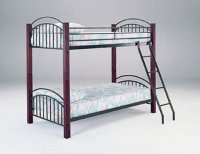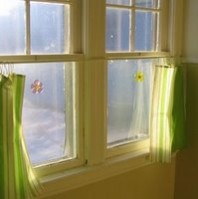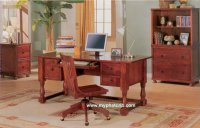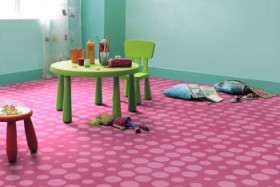January 4th, 2009
The natural focal point of the bedroom is the bed itself; this means the selection of the bed is important in establishing the overall design of a bedroom, particularly if the frame is unusually interesting. The variety of bed styles available ranges from a simple futon mat, to a traditional box spring and mattress, to a waveless waterbed, with variations and alternatives in between.
In the United States, standard sizes were established in the 1950s for bed frames and mattresses: King, 72″ x 84″; Queen, 60″ x 75″; double or full, 54″ x 52″; and single or twin, 39″ x 75″. Unless your bed is older than this, it will be one of these universal sizes, regardless of the type of bed frame. And although the sizes of American beds and bedding were standardized in the 1950s, the closest-to-standard sizes in pillows include: king, 26″ x 36″; queen, 26″ x 30″ and standard, 20″ x 26″. Other pillow sizes include French continental or eurosquare, 26″ x 26″ and the Russian pillow, 14″ x 14″.
Futons are ideal for studios and small spaces, as are Murphy beds. First introduced in 1905, the Murphy bed folds into a closet to open up more floor space when not in use. Some are hinged at the head and some hinge at the side.
 Bunk beds and trundle bed styles are space-saving alternatives to an extra bed in the guest room. Bunk beds are stacked on top of one another, while trundle beds have a second bed that slides out from underneath the first bed. Bunk beds are primarily found in children’s rooms.
Bunk beds and trundle bed styles are space-saving alternatives to an extra bed in the guest room. Bunk beds are stacked on top of one another, while trundle beds have a second bed that slides out from underneath the first bed. Bunk beds are primarily found in children’s rooms.
Tags: Bedroom, children, furniture, kids
Posted in Baby Kids Furniture, Bedroom | No Comments »
January 2nd, 2009
 Cafe curtains, which traditionally cover the lower half or bottom third of a window, offer privacy while admitting light from the top. To make them look fresh and elegant, modernize the proportions. Instead of hanging the curtains halfway up the window, he raises them one mullion higher. (Mullions are the wooden strips between panes of glass.) In a window without mullions, raise the curtain roughly a foot above the halfway point; experiment until the proportions look right. Consider curtains of white linen with a simple pinch pleat, using pinch-pleat hardware from any fabric shop.
Cafe curtains, which traditionally cover the lower half or bottom third of a window, offer privacy while admitting light from the top. To make them look fresh and elegant, modernize the proportions. Instead of hanging the curtains halfway up the window, he raises them one mullion higher. (Mullions are the wooden strips between panes of glass.) In a window without mullions, raise the curtain roughly a foot above the halfway point; experiment until the proportions look right. Consider curtains of white linen with a simple pinch pleat, using pinch-pleat hardware from any fabric shop.
Tip: Align your curtain rod with the mullions, or the window treatment will look disorganized.
Tags: curtain, Living Room
Posted in Living Room | No Comments »
January 1st, 2009
When the home office surge began, options in furniture and other equipment were limited. What was available was designed for offices, not homes. The personal computer was so new we didn’t really know what to do with it.
 But now homeowners, designers, and manufacturers are taking a figurative step back, and a second wave of office design is the result. After all, if it’s your home, why dress it like a steno pool?
But now homeowners, designers, and manufacturers are taking a figurative step back, and a second wave of office design is the result. After all, if it’s your home, why dress it like a steno pool?
Attractive, home-scaled furnishings, space-saving products and hardware, more refined textures, and both bolder and subtler colors are aimed at complementing, not clashing with, your home design. Even electronics makers changed their previously predictable beiges and grays.
Tags: furniture, Home Office
Posted in Home Office | No Comments »
December 31st, 2008
 When the baby is very small you may want to use a crib or cradle for him or her to sleep in. These should be abandoned in favour of a cot (which has greater stability) as soon as the child can sit independently - usually at about 5-7 months. A cot should be sturdily built and thoroughly safe, which means making sure that slats are not more than 6 cm (2 3/8 in) apart, that the top rails are an adequate height for protection (i.e. preventing the child falling out even when the side is lowered), that the drop-sides themselves are the sort that cannot be released by a child and that the mattress is firm and a perfect fit so that there are no dangerous gaps between it and the cot sides.
When the baby is very small you may want to use a crib or cradle for him or her to sleep in. These should be abandoned in favour of a cot (which has greater stability) as soon as the child can sit independently - usually at about 5-7 months. A cot should be sturdily built and thoroughly safe, which means making sure that slats are not more than 6 cm (2 3/8 in) apart, that the top rails are an adequate height for protection (i.e. preventing the child falling out even when the side is lowered), that the drop-sides themselves are the sort that cannot be released by a child and that the mattress is firm and a perfect fit so that there are no dangerous gaps between it and the cot sides.
Apart from the crib or cot you’ll need very little furniture. At the infant stage a trolley is a godsend (especially if it has a wheel lock) because it is versatile and moveable. You can wheel it about to have it at your elbow wherever you need it; with a baby on your lap you can’t be leaping up and down for things you’ve forgotten - the furniture has to come to you. Move the trolley by the crib or cot, use it as a stand for a baby bath or scales or general washing kit. Move it into the bathroom at bath time, if that is where you bath the baby. Later it can hold games, a tv, hi-fi, even a computer.
Another useful item at this stage is a cane or old wooden rocker or other nice capacious chair which will last through all the stages and possibly only need re-cushioning occasionally as opposed to recovering. Do choose one which does not constrict your elbows, to make feeding easier.
Tags: furniture, kids
Posted in Baby Kids Furniture | No Comments »
December 30th, 2008
 At this stage it is enough to stress that the most sensible floors should be hardwearing and easy to clean but not uncomfortable or cold or noisy. Young children spend a lot of time on the floor, sitting, crawling, lying, playing, so the covering is important. Fortunately there are plenty to choose from: planed-down and polyurethaned wood, vinyl-coated cork tiles, cushioned vinyl tiles, linoleum.
At this stage it is enough to stress that the most sensible floors should be hardwearing and easy to clean but not uncomfortable or cold or noisy. Young children spend a lot of time on the floor, sitting, crawling, lying, playing, so the covering is important. Fortunately there are plenty to choose from: planed-down and polyurethaned wood, vinyl-coated cork tiles, cushioned vinyl tiles, linoleum.
If you are going to put rugs on hard floor surfaces, make sure they are held in place with a non-slip backing; on fitted carpet they can be prevented from rucking with strips of Velcro touch-and-close fastening stitched to the back - use only the hooked side of the strip so that it will catch on the carpet tufts or loops.
Tags: children, kids
Posted in Baby Kids Furniture | No Comments »
 Bunk beds and trundle bed styles are space-saving alternatives to an extra bed in the guest room. Bunk beds are stacked on top of one another, while trundle beds have a second bed that slides out from underneath the first bed. Bunk beds are primarily found in children’s rooms.
Bunk beds and trundle bed styles are space-saving alternatives to an extra bed in the guest room. Bunk beds are stacked on top of one another, while trundle beds have a second bed that slides out from underneath the first bed. Bunk beds are primarily found in children’s rooms.
 Cafe curtains, which traditionally cover the lower half or bottom third of a window, offer privacy while admitting light from the top. To make them look fresh and elegant, modernize the proportions. Instead of hanging the curtains halfway up the window, he raises them one mullion higher. (Mullions are the wooden strips between panes of glass.) In a window without mullions, raise the curtain roughly a foot above the halfway point; experiment until the proportions look right. Consider curtains of white linen with a simple pinch pleat, using pinch-pleat hardware from any fabric shop.
Cafe curtains, which traditionally cover the lower half or bottom third of a window, offer privacy while admitting light from the top. To make them look fresh and elegant, modernize the proportions. Instead of hanging the curtains halfway up the window, he raises them one mullion higher. (Mullions are the wooden strips between panes of glass.) In a window without mullions, raise the curtain roughly a foot above the halfway point; experiment until the proportions look right. Consider curtains of white linen with a simple pinch pleat, using pinch-pleat hardware from any fabric shop. But now homeowners, designers, and manufacturers are taking a figurative step back, and a second wave of office design is the result. After all, if it’s your home, why dress it like a steno pool?
But now homeowners, designers, and manufacturers are taking a figurative step back, and a second wave of office design is the result. After all, if it’s your home, why dress it like a steno pool?

